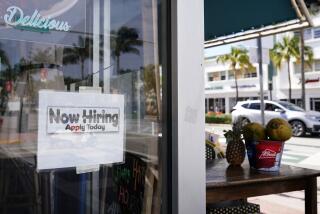Manufacturing Activity Ebbs to an 8-Year Low : Economy: Reports that business failures rose sharply as construction declined also fuel fears that a recession is near.
- Share via
WASHINGTON — A series of economic statistics released Thursday reinforced fears that the nation may be heading into a recession.
A monthly survey of manufacturing activity hit its lowest level since the 1982 recession, housing and office construction posted its biggest decline in nearly nine years, the rate of business failures rose ominously and farm production costs surged.
Taken together, the statistics provided fresh evidence that the nation is on the brink of recession. They tended to overshadow a report issued earlier in the week indicating that the economy expanded at a respectable rate during the third quarter of 1990.
In one key indicator of a declining economy, the National Assn. of Purchasing Managers reported that its composite index of manufacturing activity fell to 43.3% in October from 44.4% the previous month. October’s reading was the lowest in eight years.
The association, which surveys purchasing executives at 300 industrial companies every month, considers any reading below 50% an indication that the nation’s goods-producing industries are contracting.
The group’s declining readings have been borne out by government employment statistics: Some 500,000 factory jobs have been lost since the 1980s expansion peaked in January, 1989. In September alone, manufacturing employment fell by 65,000.
The purchasers association said a secondary index measuring new orders for industrial production fell to 43.8% from 44.5%, while another index measuring production fell to 43.0% from 45.1%. Both secondary readings also were at their lowest levels since 1982.
In a separate report, the Commerce Department said spending on new construction fell 2.8% in September to a seasonally adjusted annual rate of $429 billion, the largest monthly decline since January, 1982. September’s spending was 1.1% lower than a year earlier.
The report confirmed previous indications that America’s housing and office construction sector already is in a deep recession. Earlier this week, the department said sales of new single-family homes fell 6% in September.
Private-sector construction spending fell to an annual rate of $319 billion in September from $326 billion in August. Government spending, which includes everything from schools and hospital construction to road and bridge repairs, fell to $109 billion from $115 billion.
Meanwhile, the number of business bankruptcies jumped 14.5% nationwide during the first nine months of 1990, with the largest increases in New England and Middle Atlantic states, according to a survey by Dun & Bradstreet Corp.
Altogether, 43,836 American businesses failed through September, up from 38,296 during the same period in 1989, the business information firm reported. Higher failure rates were reported in every industry group except mining.
The biggest regional increase was posted in New England, where failures soared by 193%. In the Middle Atlantic region, failures increased 65%. The state posting the biggest gain in failures was Massachusetts, where bankruptcies more than tripled.
Only two areas posted declining rates of business failures: the East North Central region and the Pacific region, which includes California. Dun & Bradstreet attributed the improvements to demand for exports from those areas.
In yet another early warning signal of more problems ahead, the Agriculture Department said farm production costs are surging, reflecting the explosion in oil prices caused by the Persian Gulf crisis.
The department said overall agricultural production costs had risen 2.2% from August through October. That was the biggest three-month increase since 1982, when the nation was still suffering the inflationary aftermath of the oil shocks of the 1970s.
In addition to soaring fuel prices, farmers were squeezed last month by lower prices for their production. In all, the agency said, prices for raw products from the nation’s farms fell 0.7% from September to October.
Government economists project, however, that consumer food prices will rise 5% to 7% for the year, compared to a 5.8% increase in 1989.
The new statistics follow Tuesday’s Commerce Department report that the gross national product expanded at a 1.8% annual rate during the third quarter, compared to a glacial 0.4% growth rate last spring.
The GNP report confounded expectations that the economy was contracting even before the full impact of the Persian Gulf crisis had been felt. Even so, most economists remain convinced that at least a mild recession is in store during the final quarter of the year.
More to Read
Inside the business of entertainment
The Wide Shot brings you news, analysis and insights on everything from streaming wars to production — and what it all means for the future.
You may occasionally receive promotional content from the Los Angeles Times.







